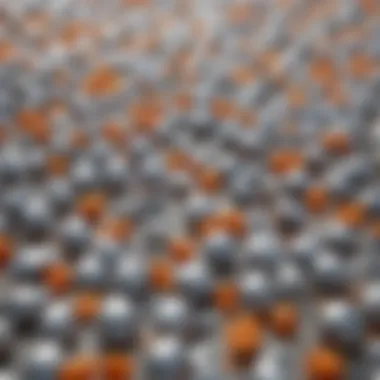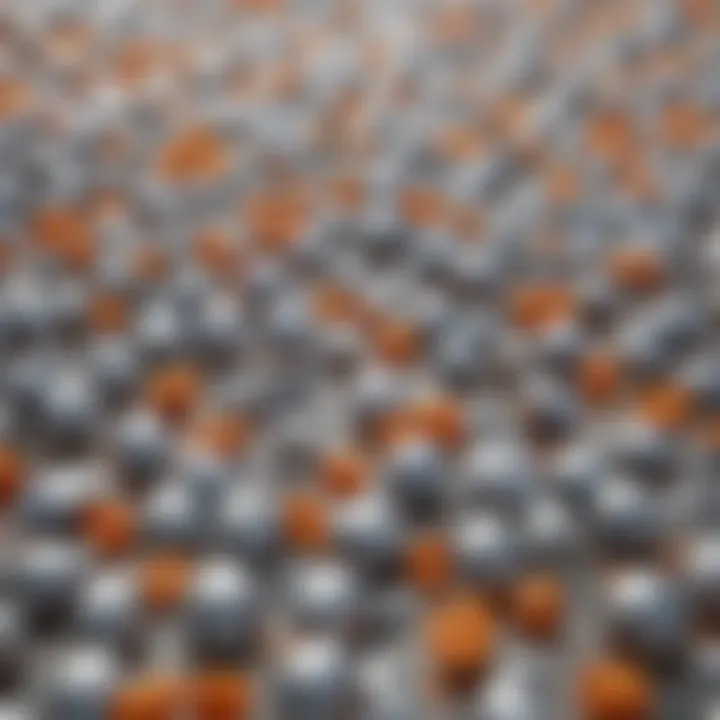Exploring Foods Rich in Zinc: A Comprehensive Guide


Intro
Zinc is an essential mineral that plays a significant role in various bodily functions. One can often overlook its importance amid popular nutrients like vitamin C or calcium. However, zinc is critical for a strong immune system and effective cellular metabolism. Given today's fast-paced lifestyle, understanding how to incorporate zinc-rich foods into one's diet is not just beneficial, it is essential for long-term health. This comprehensive guide aims to bridge that gap, presenting valuable information in a structured way, while also engaging food lovers, cooks, and homemakers.
Recipe Highlight
This section introduces a simple yet nutritious recipe: Zinc-Packed Quinoa Salad with Chickpeas. This dish serves as a versatile cornerstone for various meals, offering an easy way to elevate your zinc intake with delicious flavors.
Essential Ingredients:
- 1 cup quinoa.
- 1 can chickpeas, rinsed and drained.
- 1 cucumber, diced.
- 1 bell pepper, chopped.
- 1/4 cup chopped parsley.
- 2 tablespoons olive oil.
- 1 tablespoon lemon juice.
- Salt and pepper to taste.
Estimated Preparation Time: 20 minutes
Servings: 4
Step-by-Step Instructions
- Rinse the quinoa under cold water to remove bitterness, then cook according to package instructions.
- While the quinoa is cooking, prepare other ingredients: chop the cucumber, bell pepper, and parsley.
- Once the quinoa is done, allow it to cool slightly before combining it with chickpeas, cucumber, bell pepper, and parsley in a large bowl.
- In a separate small bowl, whisk together olive oil, lemon juice, salt, and pepper to create a dressing.
- Pour the dressing over the salad and mix well to combine.
- Serve chilled or at room temperature.
Cooking Tip: Using pre-cooked quinoa can greatly cut down on prep time.
Variations and Substitutions
You can customize this salad based on preferences or available ingredients. Here are some suggestions:
- Replace chickpeas with black beans for a different texture.
- Add avocado for creaminess.
- Introduce feta cheese for a bit of tang.
Feel free to experiment with herbs or even season it with spices like paprika or cumin to enhance the flavor profile. Pair it with grilled chicken or fish for a complete meal.
Time-Saving Cooking Tips
- Prep Ahead: Chop vegetables and prepare the dressing in advance, storing them in airtight containers.
- Use Tools Efficiently: A food processor can quickly chop vegetables, saving valuable time.
- Batch Cooking: Make a double batch of quinoa and store leftovers for other recipes throughout the week.
Nutritional Information
Per serving, this salad provides approximately 250 calories. Key nutrients included are 15g protein, 8g fiber, and important amounts of vitamins A and C. Its suitability for vegan diets makes it a versatile option for health-conscious eaters.
In addition to being aligned with various dietary plans, it also tackles the necessity of incorporating zinc into one's meals thoughtfully. From understanding the essentials to linking solutions for deficiencies, this narrative showcases the value of balanced nutrition.
Understanding Zinc and Its Importance
Zinc is crucial for various aspects of human health. As an essential mineral, it plays a significant role in multiple biological processes. The importance of understanding zinc lies not only in its benefits but also in the consequences of its deficiency. This knowledge facilitates better dietary choices and health outcomes. Assessing dietary zinc intake is relevant for everyone, from active individuals to children and adults. Given the modern dietary trends that may lead to failure in obtaining adequate zinc, it warrants a critical focus on this micromineral.
Definition of Zinc
Zinc is a transition metal and a vital trace element that is essential for human health. It is integral for over 300 enzymes in the body as they facilitate various biochemical reactions. The mineral is naturally present in many foods and can also be taken as a dietary supplement. Unlike some vitamins that require daily intake due to watersolubility, zinc has a unique property. The body can store zinc, but that does not diminish the need for consistent intake to replace losses through secretion.
Role of Zinc in the Body
Immune Function
Zinc is pivotal for the immune system. It supports the development and function of immune cells, which are integral in defending the body against pathogens. A strong immune response relies on adequate zinc levels. Low levels can hinder the ability to fight off infections and increase susceptibility to diseases. As such, sufficient zinc intake is instrumental in promoting resilience against illnesses.
Cell Growth and Repair


Cell growth and repair are significantly influenced by zinc's presence in the body. The mineral is crucial during periods of growth, such as childhood and adolescence. It aids in DNA synthesis, thus facilitating proper cellular functions. Additionally, sufficient zinc levels are vital when the body is repairing tissues or recovering from injuries. Therefore, it is an essential nutrient for those engaged in any physical training or recovering from surgery.
Protein Synthesis
Protein synthesis involves the creation of proteins from amino acids. Zinc assists in the functioning of specific enzymes that are required for this process. Without adequate zinc, protein synthesis can slow down. This slow process affects muscle health and overall body functioning. Athletes or individuals looking to build muscle should consider the importance of this mineral.
Wound Healing
Wound healing is another critical function wherein zinc plays a role. The mineral is necessary for the proliferation of cells, collagen synthesis, and inflammatory responses found in injury recovery. It helps heal cuts and wounds. Ensuring enough zinc intake can expedite recovery times and reduce potential complications, making it an important consideration for those prone to injuries.
Consequences of Zinc Deficiency
Weakened Immune Response
Weakened immune response is closely linked to low zinc levels. When the body lacks adequate zinc, the immune system cannot operate optimally. There is a higher risk of infections, making zinc deficiency a public health concern. Such deficiencies are often hidden, as symptoms can be vague and gradually develop.
Growth Delays
In children, zinc deficiency often leads to growth delays. The mineral is critical during formative years. Insufficient intake during those stages can result in stunted growth and delayed maturation. The implications of delayed growth can create future health complexities, as children face various developmental hurdles.
Skin Issues
Skin issues are another significant consequence of inadequate zinc. Many people find they encounter frequent skin irritations or blemishes if their zinc levels are insufficient. Zinc plays a role in cell turnover and healing, reducing incidences of acne and eczema. Addressing zinc deficiency might minimize these skincare problems and promote healthier skin overall.
Food Sources of Zinc
Zinc is a critical mineral that benefits various bodily functions. Sourcing zinc effectively is central for optimal health. Having a balanced diet that prioritizes zinc-rich foods can address daily requirements and contribute to long-term health.
Animal-Based Sources
Meat is one of the most abundant sources of zinc. It provides significant amounts compared to plant sources. Lean cuts of beef and pork are particularly rich in zinc. Their primary attraction lies in their high bioavailability, allowing the body to absorb zinc efficiently. Prepared types of highlights like grilling or roasting meat can further help deliver essential nutrients while avoiding excess fats.
Meat: Beef and Pork
Beef and pork have one of the highest concentrations of zinc among food sources. Serving examples like grilled steak or roasted pork meat can deliver almost double iron and zinc compared to alternatives. Their rich nature means a single serving meets a significant part of recommended dietary values. One key aspect of these meats—it’s this palatability that anchors their place in the diet. However, moderation is always wise; consuming processed meats excessively could outweigh their benefits.
Seafood: Oysters and Crabs
Oysters are well-known and widely recognized for containing unparalleled levels of zinc. Not only do they taste delightful, but they also offer a nutrient profile that stands out. Being low in calories, they suit various dietary preferences. Furthermore, crabs provide a good backup option rich in zinc if oysters are unavailable. While their preparation might require slightly more work, adopting simple steaming methods could retain flavors.
Poultry
Poultry such as chicken and turkey contributes well to zinc intake. A skinless grilled chicken breast or baked turkey tickets offer feasible ways to incorporate lean protein into the diet. They are considerably lower in zinc compared to beef and seafood but still provide essential nutrients. This can allow people who manage their red meat consumption to find a tasteful alternative. Uncooked poultry can stand significant safety hazards and must be stored rightly to maximize benefits.
Plant-Based Sources
Plant sources may hold various nutritional values but tend to provide zinc in lesser amounts and with lower bioavailability because of competing components. However, with proper combinations, they can still significantly contribute to daily needs.
Legumes: Chickpeas and Lentils
Legumes, including chickpeas and lentils, are good sources of zinc, aside from being two of the role-plays for protein and fiber content. Dishes like chickpea salad or lentil soup approach both tastefulness and nutrition. It is important to note that phytates in legumes can inhibit absorption, so pairing with cumin or lemon can improve uptake.
Nuts and Seeds
Nuts and seeds present a varied singleton choice for zinc-rich alternatives. Pumpkin seeds, for example, distinctively show higher zinc levels, presenting an easy snacking option. They are versatile too and can complement cereals or yogurts. Though high in healthy fats, control cultural portions recommended to avoid unwanted caloric intake.
Whole Grains


For zinc sources from grains, whole grains like quinoa and brown rice offer valuable nutrients. Their multigrain appearance contributes additional fibers while keeping energy levels sustained. Baking with nuts and seeds along with whole grains combines flavors while augmenting zinc content. Though they come with a fibrous component curtails precise uptake of zinc, they are still beneficial overall.
Fortified Foods
Some food products are fortified with zinc, making it easier for people to meet their daily requirements—cereal brands often enhance their formulas with extra zinc, while nutrition bars posit a concentrated source.
Cereals
Cereals are appealing to many as a quick breakfast option, especially those prepared with whole grains and enriched with zinc. Readily available on supermarket shelves, many cereals could offer up towards 100% daily value in single servings. The efficiency these cereals offer represents a highly beneficial trait for busy mornings or those seeking easy-to-prepare meal. Intermediate brands differ greatly in nutritional capacities and ingredients; being intentional about choices matters.
Nutrition Bars
Nutrition bars have surged in popularity as healthy-on-the-go solutions. Many types offer supplemental zinc alongside added vitamins. Types including granola bars blend different ingredients for taste while improving nutritional profiles. Despite nepoints of chocolate coatings, sugar content remain an aspect one should member consideration when selecting these premier all functional spots.
Dietary Supplements
In some instances, achieving your zinc intake purely from foods may prove difficult. Thus, dietary supplements can fit into solutions—a diverse placing scenario tackling individual preferences.
Zinc Tablets
Tablets provide quick and multi-functional staple for those merely looking to cover daily intake thorough specification. Dosage guidance plays an essential role indicating effective yet safe usage. Being direct, some formulations contain different zinc salts, emphasizing practice to associate commodifying solutions. Effectively capped sweetening all output assessments contribute towards their popularity.
Multivitamins with Zinc
Multivitamins that include zinc offer increased ease for all-round nourishment. They present reliable coverage while integrating additional key minerals and vitamins is an advantage if seeking broader supplement effects. Select multiple reputable brands accords proper deliveries, but stratification is crucial—cash that contains clinically adequate zoning ensure overall safety at that benefit resolve.
Consuming an adequate amount of zinc is essentials for maintaining immune functions and cellular repair in favorable reference framework.
Ultimately, diversifying food choices while prioritizing those rich in zinc can tether optimal health.
Determining Dietary Needs
Understanding dietary needs is essential, especially when discussing minerals like zinc. Zinc serves multiple vital roles in the body. Therefore, determining the right amount based on different groups helps to maintain overall health. Recognizing individual needs based on age, gender, and specific life stages can guide better dietary choices, ensuring sufficient intake of this critical mineral.
Recommended Daily Intake for Different Groups
Children
Children need zinc to support growth and development. Their bodies are constantly changing, requiring nutrients that will help to build strong immune systems and foster growth in tissues. Adequate zinc not only reinforces their emerging immune response but also promotes cognitive development. However, care can be taken to ensure they do not overconsume, as excess zinc can lead to adverse effects like nausea and lethargy.
The recommended intake varies with age:
- Ages 1-3: 2 mg/day
- Ages 4-8: 5 mg/day
- Ages 9-13: 8 mg/day
Adults
For adults, zinc continues to play a role in metabolic function, immune support, and overall well-being. The daily requirement for men tends to be higher, approximately 11 mg, compared to the 8 mg that is recommended for women. Understanding these figures can emphasize the usual variations based on individual lifestyle choices and health.
A healthy intake of zinc can assist in improving wound healing and protein synthesis. Nonetheless, an improper balance could potentially lead to nutritional conflicts with minerals like copper, affecting overall mineral levels in the body.
Pregnant and Lactating Women
Pregnant and lactating women have distinct nutritional demands. Increased zinc is necessary for fetal growth and development during pregnancy. The recommended zinc intake is set at 11 mg per day during pregnancy and goes up to 12 mg during lactation. They must keep a check to ensure adequate intake to support both their needs and those of the child.
During breastfeeding, the metabolism changes can hardly store enough zinc in breast milk, hence requiring increased focus on zinc-rich sources in the diet. Failing to consume enough zinc may impact the baby's development, leading to increased concern over intellectual and physical health milestones.


Factors Affecting Zinc Needs
Age and Gender
Zinc requirements change with age and gender. Growing children, toddler and teenage boys often exude the greatest demand due to growth spurts and developmental needs. Conversely, adult women may have higher needs during specific life stages, as mentioned in prior sections. Adaptability is key to meet these changes over time.
Health Conditions
Certain health conditions can increase the need for zinc. For example, persons suffering from gastrointestinal diseases may absorb less zinc from their diets. Thus, their needs perspectively climb higher. Individuals engaging heavily in exercise may also require adequate zinc, given that exercise itself can lead to electrolyte loss
Dietary Restrictions
Dietary restrictions can introduce new challenges for zinc intake. Vegan and vegetarian diets can often be low in this mineral due to its presence in animal-based products. Adapting food choices within these restrictions, such as incorporating nuts, seeds, and legumes, is essential to fulfill the dietary holes those preferences might create.
Absorption and Bioavailability of Zinc
Understanding absorption and bioavailability of zinc is crucial. These factors significantly influence how our bodies utilize this vital nutrient. Zinc's roles include maintaining immune function, aiding metabolism, and supporting wound healing. However, consuming zinc alone doesn't guarantee its effectiveness in the body. Understanding how to maximize aid in absorption can lead to healthier dietary choices and better outcomes.
Factors Affecting Zinc Absorption
Phytates in Plant Foods
Phytates are natural compounds found in many plant foods that can inhibit zinc absorption. They bind zinc and other minerals in the digestive tract, making them less available for the body. This is most prominent in foods such as beans, legumes, and whole grains. While phytates may limit mineral absorption, they also possess antioxidant properties and offer other health benefits. Incorporating a balanced diet that includes zinc-rich foods while being mindful of phytate levels can help manage absorption effectively.
Competing Minerals
Several minerals can compete with zinc for absorption in the gut. Calcium, iron, and copper are examples. A high intake of these minerals may lead to simply less absorbed zinc. Each mineral plays vital roles in our bodies, but their presence must be balanced. In contexts like a varied diet or supplementation, the proportions of these minerals can impact zinc's bioavailability. Focusing on moderation is key to achieving the right blend for optimal zinc uptake and overall nutrition.
Enhancing Zinc Absorption Through Diet
Combining Food Sources
Combining different food sources can effectively enhance zinc absorption. Pairing zinc-rich animal products with plant-based foods, or consuming vitamin C-rich fruits alongside can increase mineral accessibility. For example, having lentils (containing zinc) with a squeeze of lemon (rich in vitamin C) can aid absorption. This approach highlights culinary choice's role in nutrition. It encourages a more interconnected view of meals, rather than purely focusing on individual nutrient values.
Cooking Methods
The methods used in food preparation can also impact zinc availability. Cooking certain foods can reduce the levels of phytates and improve bioavailability. Boiling, roasting, or soaking legumes may lead to more significant nutrient advantages. However, some methods, such as prolonged hyrdation, could risk diluting essential minerals. Focusing on optimizing cooking methods can maximize nutrition while maintaining flavors and texture in dishes.
"Understanding how to prepare and combine food is as critical as choosing the right foods for adequate zinc supply."
Closure
In any article about nutrition, the conclusion serves as a vital synthesis of all the missable insights. This is especially key when discussing the importance of zinc, a mineral that plays critical roles in the human body. As we reviewed throughout this guide, zinc is fundamental for immune function, cellular metabolism, and numerous physiological processes.
Synthesis of Information
Through this exploration, it becomes clear that incorporating zinc-rich foods into the diet is essential. We began by discussing the definition and significance of zinc. It was apparent that this mineral is not just a nutrient; it's a pivotal player in maintaining health.
The unfolding narrative led us through various food sources. Animal-based foods such as beef, pork, and oysters emerged as top performers in zinc content, providing high bioavailability. At the same time, the article addressed plant-based sources. Legumes, nuts, and seeds contain zinc but in lesser amounts due to the presence of substances like phytates. We also evaluated fortified foods and dietary supplements, offering additional routes for those struggling with adequate intake.
Factors influencing dietary needs were elaborated, outlining that not all individuals have the same requirements. Age, gender, health status, and specific dietary preferences influence how much zinc one should aim to include in their daily intake.
Lastly, we examined crucial aspects to consider when optimizing zinc absorption through dietary modifications. Cooking methods, food combinations, and avoiding inhibitors can elevate the efficacy of zinc consumed.
Encouragement for Nutritional Awareness
Navigating nutrition in today's fast-paced world is often challenging. However, raising awareness about zinc’s role is essential for overall well-being. An informed dietary approach empowers individuals to make decisions aligning with their health goals.
Being aware of food choices, particularly the sources of zinc one consumes, leads to enhanced immune function and better overall health. Incorporation of simple, local foods can significantly bridge the gap of deficiency.
Furthermore, considering the impact of dietary restrictions on zinc intake presents another layer of awareness. Individuals following restrictive diets need to plan effectively to ensure adequate zinc levels are maintained. Strategies, such as synchronized eating—pairing foods to increase absorption—can make a substantial difference.
In sum, understanding and recognizing zinc's importance offers a path towards improved nutrition. By fostering a proactive stance towards dietary needs, everyone can cultivate health more efficiently. Thus, the synthesis of all our findings serves to educate and guide you towards smarter food choices—where quality dietary habits cultivate days of vitality and health.







